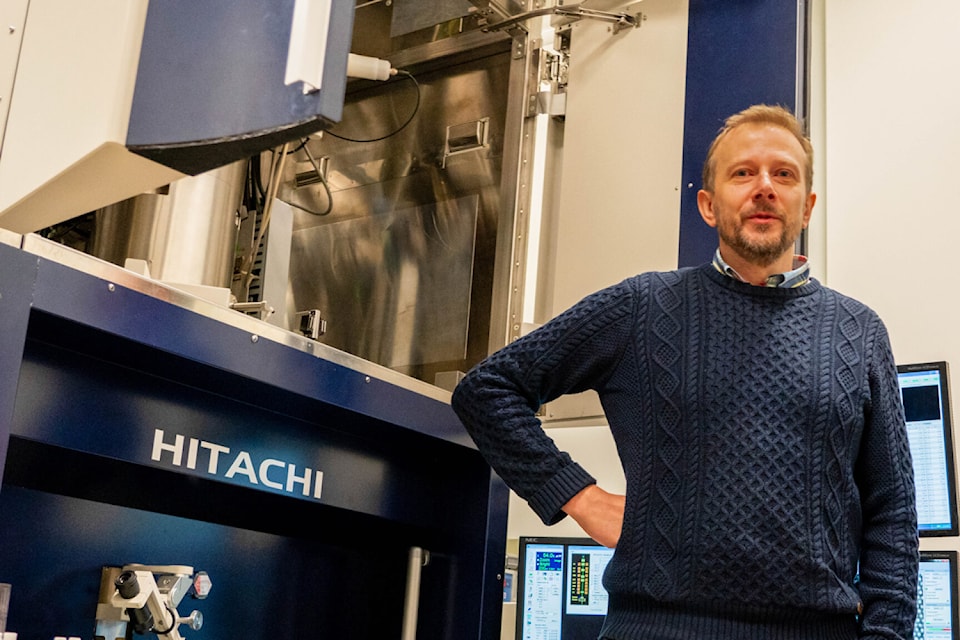Science
Researchers Achieve Major Breakthrough in Microscopic Imaging

A team of researchers at the University of Victoria has made a significant advancement in electron microscopy, enabling scientists to visualize atomic-scale structures with more accessible technology. Led by Arthur Blackburn, co-director of the university’s Advanced Microscopy Facility, the team developed an innovative imaging technique that achieves sub-Ångström resolution—less than one ten-billionth of a metre—using a compact, low-energy scanning electron microscope (SEM).
This breakthrough, detailed in the journal Nature Communications, stands out as it allows for high-resolution imaging without the high costs and complex setups typically associated with traditional methods. Previously, such precision required large and expensive transmission electron microscopes (TEMs). Blackburn, who holds the position of Hitachi High-Tech Canada Research Chair in Advanced Electron Microscopy, explained, “This work shows that high-resolution imaging doesn’t have to rely on expensive, complex equipment.”
The novel technique employed by the researchers utilizes overlapping patterns of scattered electrons to construct highly detailed images of samples. By doing so, the team achieved a remarkable resolution of just 0.67 Ångström, which is even smaller than the size of an atom and just one-tenth the width of a human hair. This new method paves the way for more laboratories worldwide to explore atomic-scale imaging without prohibitive costs, space constraints, and staffing needs.
Implications for Science and Industry
The implications of this advancement extend across various fields, potentially transforming areas such as materials science, nanotechnology, and structural biology. Blackburn noted, “The advance will most immediately benefit the research and production of 2D materials, which are promising in the development of next-generation electronics.”
In the long term, this technique could also provide insights into the structure of small proteins, thereby advancing health and disease research. The combination of relatively simple SEM technology with sophisticated computational techniques enables researchers to explore new frontiers in science, making atomic-scale imaging more feasible for institutions with limited resources.
This achievement reflects the growing trend towards democratizing advanced scientific tools, ensuring that groundbreaking research is not limited to well-funded laboratories. As access to high-resolution imaging becomes more widespread, it is likely to spur innovation and discovery across multiple disciplines, benefiting both academia and industry on a global scale.
-

 Politics4 weeks ago
Politics4 weeks agoSecwepemc First Nation Seeks Aboriginal Title Over Kamloops Area
-

 World5 months ago
World5 months agoScientists Unearth Ancient Antarctic Ice to Unlock Climate Secrets
-

 Entertainment5 months ago
Entertainment5 months agoTrump and McCormick to Announce $70 Billion Energy Investments
-

 Science5 months ago
Science5 months agoFour Astronauts Return to Earth After International Space Station Mission
-

 Lifestyle5 months ago
Lifestyle5 months agoTransLink Launches Food Truck Program to Boost Revenue in Vancouver
-

 Technology3 months ago
Technology3 months agoApple Notes Enhances Functionality with Markdown Support in macOS 26
-

 Lifestyle3 months ago
Lifestyle3 months agoManitoba’s Burger Champion Shines Again Amid Dining Innovations
-

 Top Stories2 months ago
Top Stories2 months agoUrgent Update: Fatal Crash on Highway 99 Claims Life of Pitt Meadows Man
-

 Politics4 months ago
Politics4 months agoUkrainian Tennis Star Elina Svitolina Faces Death Threats Online
-

 Sports5 months ago
Sports5 months agoSearch Underway for Missing Hunter Amid Hokkaido Bear Emergency
-

 Politics5 months ago
Politics5 months agoCarney Engages First Nations Leaders at Development Law Summit
-

 Technology5 months ago
Technology5 months agoFrosthaven Launches Early Access on July 31, 2025





















